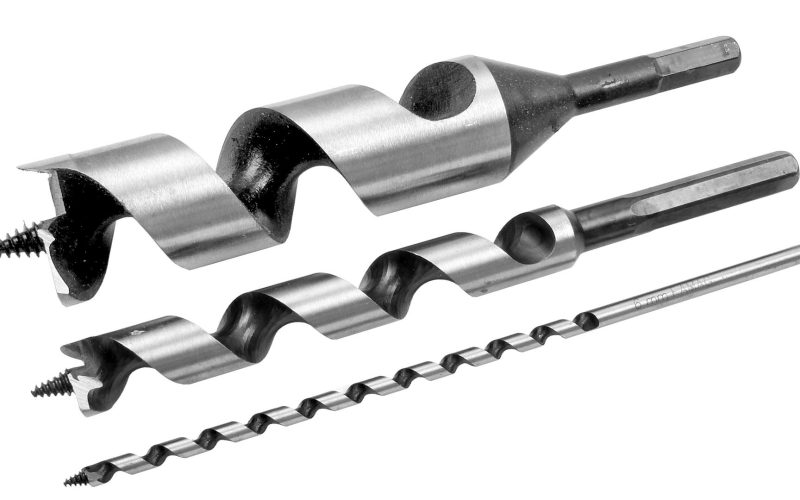Auger bits are an essential part of every woodworker’s toolbox. They come in different varieties and may be called by different names depending on where you live and who you talk to.
By familiarizing yourself with the most common types of auger bits and their most effective uses.
You can learn to match the right bit to the job and boost your productivity and accuracy.
This saves time and money. Let’s examine the different types of auger bits and how they can be used.
What are Auger Bits?
Auger bits are drill-like tools for drilling straight holes, especially wood.
They have a rotating shaft that accepts a drill bit, much like a screwdriver accepts the screw.
Auger bits come in various lengths but can be up to 6 feet long. Shorter augers (18) are usually used with handheld drills, and longer augers (36) require power drills.
Construction of an Auger Bit
An auger bit is a woodworking tool typically used in carpentry and heavy-duty jobs such as mining. All types of auger bits have a common construction.
The auger has a helical blade called an auger tooth, which cuts through the material it is fed into. The design of an auger bit can vary depending on its application.
For example, for construction, one might use a straight cutting head with cutting teeth on the side angled upwards at 45 degrees.
This is so that material does not flow back out of the hole when the bit withdraws.
A single row of straight-cutting heads can be used in either direction around the circumference to remove the waste between joints and create dowel holes or mortises.
Different Types of Auger Bits
1. Earth Auger
An earth auger is a type of auger bit with a metal tube that cuts through the ground. It can also be used to break up frozen earth by drilling holes.
Earth augers are mainly used for planting trees, drilling soil samples, water wells, drainage ditches, pipelines, and other purposes.
The rod part of the earth auger drills into the ground through rotation and pressing down on the drill shaft with your foot.
Earth augers come in different sizes: small (10-12 inches), medium (14-16 inches), or large (18-20 inches).
Small size – usually no more than 12 inches in length; mainly used for tree planting when you need to make a hole deep enough for installing root ball without collapsing sides
Medium size—14-20 inches in length. It is used when you want to drill very deep holes, such as water wells.
Large size – 20-26 inches in length. It is used primarily for boring big holes in rocky areas where it is hard to use an ordinary bit because it will get stuck too easily.
2. Ice Auger
An ice auger is a drilling tool that extracts water from ice. It can be thought of as an extension of a water pump.
An impeller blade at the end of the shaft draws in water and chops it into small pieces, forcing it out the nozzle. The action of chopping draws in more water.
An ice auger will help you extract clean drinking water from an ice or snow bank in an emergency where electricity or petrol is unavailable.
This is done by cutting a series of 1/2-inch (1 cm) holes across the top layers until reaching fresh flowing water near the surface below. Ice should be 12-18 inches (30-45 cm) thick for this method to work properly.
3. Concrete Auger
A concrete auger is also one of the different types of auger bits with screw-like cutting edges that cut through concrete. The holes made by the cutting edges are conical in shape.
A benefit to using a concrete auger for drilling is that you don’t need to mix mortar and water before drilling like you would when using a masonry bit.
They are designed to cut cleanly with less vibration than a rotary hammer drill or a masonry bit. The type of tip on your drill can also affect the process.
So, if you’re looking for clean-cut types of auger bits, then a concrete auger might be what you’re looking for.
4. Carbide-tipped Auger Bit
A carbide-tipped auger bit is perfect for harder materials like concrete, which can dull the cutting edge of a conventional steel-tip bit.
Carbide bits are usually made from titanium carbide (TiC), a very hard ceramic material.
A TiC-bladed auger bit is a great choice for drilling into the ground to lay sewer or utility lines or digging up an unwanted tree stump.
TiC blades can bore through the tough earth at high speed while being surprisingly tough against breaking or bending.
For example, when working with materials such as basalt, brick, or concrete up to 900 pounds per square inch (psi) in hardness–most other bits are quickly destroyed.
The carbide tip is much harder than the steel it replaces but wears out quickly.
These types of bits are expensive and need to be replaced often. They also produce more heat than standard bits, so it’s best not to use them on soft ground.
5. Steel-Tip Bit
The steel tip bit is next on our list of different types of auger bits. Steel tips wear down over time but can still cut most surfaces without damaging them.
These are cheaper than carbide tips but should be replaced more often because they’re not as hard or durable.
These auger bits have specially designed points that won’t crack bricks or drill holes too big in contact with rock surfaces below it.
This makes working on these types of surfaces safer since less noise is produced when it contacts rocks below the surface.
6. Triple-fluted Wood Bit
The triple-fluted wood bit is the most common auger bit. It creates holes in various materials, including brick, soft brick, concrete, stone, and asphalt.
The side flutes make it much easier to bore through material that is not constantly being pushed. This is because working through the ground doesn’t require as much effort.
These bits are usually around 1 inch thick, with a shaft size corresponding to the material you’re trying to drill into. A 3/8 triple-fluted wood bit will usually be about three inches long.
When choosing a triple-fluted wood bit, choose one made from high-quality steel and designed for constant use in residential applications.
7. Wood Boring Auger
A wood boring auger is one of the different types of auger bits designed to bore into wood. It has cutting edges to help cut the surface inside the hole.
The auger’s shaft is rigid, and a threaded head turns it. There are two types of heads: helical flutes and straight flutes.
Straight flutes create more frictional force while cutting, so they tend to drill into harder materials better than helical flutes.
Common Auger Sizes
The common sizes of auger bits are 1/4, 3/8, 1/2, 5/8, 3/4, 7/8, and 1 ft.
The augers on these types of auger bits drill holes into dirt or other ground-based materials to create tunnels or to remove the material altogether.
The lengthier the bit, the more powerful it becomes. You may have seen electric or gasoline-powered augers for large commercial construction projects extending up to 50 feet long.
Conclusion
Auger bits are quite commonly used in the drilling industry, and there are many reasons for this.
Their ability to plunge into the ground at any angle makes creating holes in almost any material easy.
They also remove dirt while they bore holes. This is especially useful for landscaping and construction projects.
Finding the right one can be tricky, with so many different types of auger bits on the market, unless you know exactly what you’re looking for and where it will be used.
Frequently Asked Questions
When drilling holes in wood, there are three types of auger bits: spades, right-hand spirals, and left-hand spirals. The desired size or orientation usually determines the type you use. Spade bits are used to drill through short holes, while right-hand spiral augers make cuts from outside the workpiece towards the center.
Auger bits are usually made of either solid or hollow steel with a precision-cut hole in the end. These cut holes spiral outward to create a screw-like thread, which screws into hard materials such as wood. Many augers also have a pilot bit that guides the main cutting edge on the auger.
Auger bits are designed for drilling deep holes. A power drill is not recommended for using an auger bit because the auger bit does not have a point that will make the hole go in one direction. This can cause the drill to become clogged with dirt or rock.








